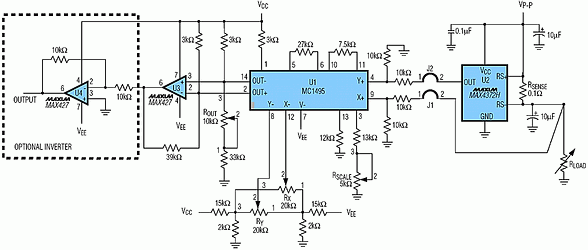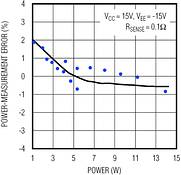
Power meters provide an early warning of thermal overload by monitoring the power consumption in 'high reliability' systems. Power monitoring is especially suitable for systems in which the load voltage and current are both variable such as industrial heating and motor controllers.
Such a power meter/controller (Figure 1) is based on the principle that power equals the product of current and voltage. Its typical accuracy is better than 1%.

Method
A current sensor (U2) measures output current, and a four-quadrant analog voltage multiplier (U1 and U3) generates the product of output voltage and current. An optional unity-gain inverter (U4) inverts the inverted multiplier output. This power meter is most accurate for multiplier inputs (J1 and J2) between 3 V and 15 V.
Choose the current-sense resistor, RSENSE, as follows:
RSENSE (Ω) = 1/P (W)
where RSENSE is in Ω and P is the output power in W. If power delivery to the load is 10 W, for instance, choose RSENSE = 0,1 Ω.
The Figure 1 circuit, with a 0,1 Ω sense resistor, has a unity-gain transfer function in which the output voltage is proportional to load power. For instance, the output voltage is 10 V when the load power is 10 W. To change the gain transfer function, change the sense resistor as follows: Gain = 10 RSENSE.
Figure 2 compares power-measurement error with load power for the Figure 1 circuit. Note that the accuracy is better than ±1% for load power in the 3 W to 14 W range.

Calibration
For proper operation, the analog multiplier must first be calibrated according to the following procedure (which also appears in Motorola's MC1495 data sheet). To calibrate the multiplier, remove jumper J1 (X input) and J2 (Y input), and use the following procedures:
(1) X-input offset adjustment: Connect a 1,0 kHz, 5 VP-P sinewave to the Y input, and connect the X input to ground. Using an oscilloscope to monitor the output, adjust RX for an AC null (zero amplitude) in the sinewave.
(2) Y-input offset adjustment: Connect a 1, 0 kHz, 5 VP-P sinewave to the X input, and connect the Y input to ground. Using an oscilloscope to monitor the output, adjust RY for AC null (zero amplitude) in the sinewave.
(3) Output offset adjustment: Connect both X and Y inputs to ground. Adjust ROUT until the output DC voltage is zero.
(4) Scale factor (Gain): Connect both X and Y inputs to 10 V d.c. Adjust RSCALE until the output voltage is 10 V d.c.
(5) Repeat steps 1 through 4 as necessary.
| Tel: | +27 11 608 0070 |
| Email: | [email protected] |
| www: | www.cstelectronics.co.za |
| Articles: | More information and articles about CST Electronics |

© Technews Publishing (Pty) Ltd | All Rights Reserved